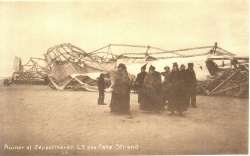The Wireless Conquers the Sky
01. Nov. 2005

This machine gun was removed from the wreck before it was set on fire by the men who all sur-vived. Property of Bangsbo Museum.
A War Machine
The first international passenger flight by zeppelin took place in 1912 and a serious future competitor to the large passenger liners was born. But the zep-pelins would only hover like friendly whales in the sky for a couple of years before everything was changed. When World War I broke out, the zeppe-lins transformed into gruesome killer whales. With the zeppelin the Germans had a long-range war machine and at the outbreak of the war they started to construct zeppelins for military use.
Radio Contact was not enough
On 17th of February 1915 the German airship L3 had been sent on a reconnaissance mission at the Norwegian coast. The airship had taken off with only to of its three engines functioning. This proved to be fatal as a heavy snowstorm finished off an-other engine, so the airship was no longer man-oeuvrable. The commander of the airship, Captain Fritz, realized his setback and asked the telegraph operator to send a radio telegram. They were near Lyngvig and he had decided to turn back.
Captain and crew were struggling for hours, but they had the wind against them and the engines could not drive the propellers with the necessary power. The telegraph operator had to work hard be-cause the crew had eventually realized that it would be impossible to get back to Hamburg. This time they telegraphed the German navy for help. Shortly afterwards they received a reply from the commander-in-chief: It would take 6 hours for a tor-pedo boat to reach their position and as such there was no chance of getting any help.

The wrecked airship and curious spectators wearing the traditional Fanoe costumes. Illustration from Nordby Parish Archives.
After a quick deliberation among the crew members they decided to try to get to the northernmost Ger-man airship base which was situated in Tønder only 40 km south of the then Danish-German bor-der. It proved, however, to be an unattainable des-tination as the last engine cut out and the airship was drifting in the wind. To avoid drifting out over the North See the crew emptied the gas cells of hydrogen and late in the afternoon the airship crash-landed on the north-western shore of the Danish island of Fanoe.
Radio Security in Time of War
An international radio conference took place in the summer of 1912. As at a similar conference six years earlier distress signals and international regulation were in the programme. In the wake of the loss of the Titanic a couple of months earlier the subject was highly topical. At that time there were no fixed rules that transceivers on board ships should be manned day and night. There had been many speculations whether all passengers of the Titanic might have been saved if the telegraph operator on the nearest ship had not gone to bed for the night. The outbreak of World War I in 1914 meant a temporary stoppage of the international cooperation in the radio field.
This article may be copied or quoted with MuseumsPosten, Post & Tele Museum as source.
Comment this article
Only serious and factual comments will be published.